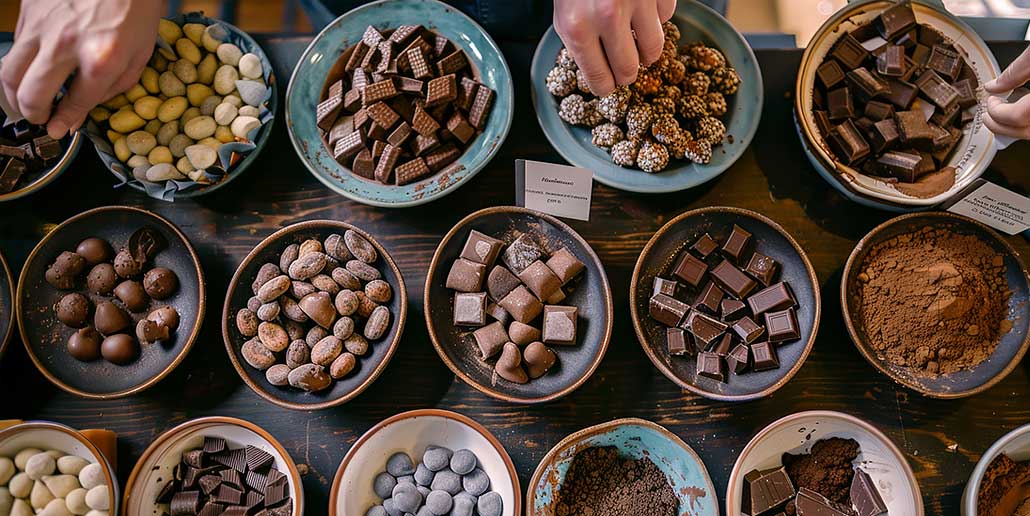
A Journey Through Chocolate
Chocolate is often called the “universal language of love,” and for good reason. From the bustling markets of Mexico to the artisanal boutiques of Belgium, chocolate weaves its way into celebrations, comfort foods, rituals, and everyday pleasures around the globe. Yet, despite its global popularity, the way chocolate is crafted, consumed, and revered varies wildly between cultures.
In this new blog series, Chocolate in Different Cultures, we’ll take a delicious journey across continents to discover how different regions shape chocolate traditions, flavours, and innovations. From ancient rituals to modern culinary artistry, chocolate tells a unique story wherever it goes — and it’s a story well worth savouring.
A Brief History of Chocolate’s Global Expansion
Chocolate’s roots trace back thousands of years to ancient Mesoamerica, where the Maya and Aztec civilizations revered cacao as a sacred gift. Cacao beans were so valuable that they were used as currency, and cacao-based drinks were a part of religious ceremonies and royal feasts. But chocolate back then was a far cry from the sweet treats we know today; it was primarily consumed as a bitter, spiced beverage, often mixed with chilli peppers and maize.
In the early 16th century, Spanish explorers brought cacao beans back to Europe. There, sugar and milk were added, transforming cacao into a sweeter, more palatable drink that quickly became a favourite among the European aristocracy. Over the centuries, chocolate evolved from an elite indulgence into a more accessible treat as techniques for mass production improved during the Industrial Revolution.
By the 19th and 20th centuries, chocolate had firmly established itself as a beloved food worldwide. Brands like Cadbury, Lindt, Hershey, and Nestlé helped popularize chocolate in North America and Europe, while cacao plantations expanded across Africa, Southeast Asia, and Oceania to meet global demand.
Today, chocolate is both a nostalgic comfort and a platform for culinary innovation. As small-batch, ethical, and artisanal chocolates grow in popularity, there’s a renewed focus on cacao’s origins and the traditions behind it — breathing new life into this ancient treasure.
Why Chocolate Differs Across Cultures
Although cacao originated in Central America, its adoption by various cultures has given rise to wildly different chocolate traditions, each influenced by local tastes, available ingredients, climate, and culinary philosophies.
In North America, chocolate often leans toward mass-market candy bars and nostalgic treats, but there’s also a booming artisan movement focused on bean-to-bar craftsmanship and ethical sourcing. In Mexico, chocolate retains its sacred character, especially in traditional drinks and savory dishes like mole.
Europe is synonymous with fine chocolate craftsmanship. Countries like Switzerland, Belgium, and France have elevated chocolate to an art form, specializing in luxurious pralines, silky ganaches, and elegant truffles. Meanwhile, in Italy, chocolate often carries rich notes of hazelnut and remains closely tied to regional culinary traditions.
In Latin America — where cacao trees have always grown wild — chocolate traditions are deeply rooted in indigenous heritage. Traditional preparation methods, such as grinding cacao with stone tools and blending it with spices, are still honored today.
Asia, despite being a relatively new player in the cacao industry, has infused chocolate with local flavors like matcha, yuzu, black sesame, and chai spices. Japan, in particular, has developed a unique chocolate culture, with high-end luxury chocolates and playful seasonal creations.
Africa is the world’s largest producer of cacao, yet until recently, it had little local chocolate production. That’s changing fast, as new African-owned brands are crafting bean-to-bar chocolates that showcase the region’s rich cacao heritage. And in Oceania, Australia and New Zealand are emerging as exciting centers of craft chocolate, often featuring native ingredients like macadamia nuts and finger lime.
In every region, chocolate has adapted and evolved — influenced by history, geography, economy, and creativity — resulting in a beautifully diverse global chocolate culture.
What You’ll Discover in This Series
Over the next several posts, we’ll explore how each region embraces and innovates with chocolate. Here’s a taste of what’s to come:
- North America: From mass-market icons like Hershey’s to a booming craft chocolate movement and indigenous Mexican traditions.
- Latin America: The birthplace of chocolate — a look at ancient rituals, traditional recipes, and today’s fine cacao producers.
- Asia: Where innovation meets tradition, blending bold new flavors with emerging cacao farming regions.
- Europe: The heartland of chocolate craftsmanship, home to pralines, ganaches, and some of the world’s most famous chocolate houses.
- Africa: From cacao farms to new artisan brands, a spotlight on the continent’s crucial role in the chocolate industry.
- Oceania: An emerging hub for bean-to-bar chocolate and native flavor innovations.
Whether you’re a casual chocolate lover, an aspiring chocolatier, or a cultural enthusiast, this series will give you a deeper appreciation for how chocolate connects — and distinguishes — cultures around the world.
So grab your favorite chocolate bar, settle in, and get ready to embark on a sweet journey like no other.

